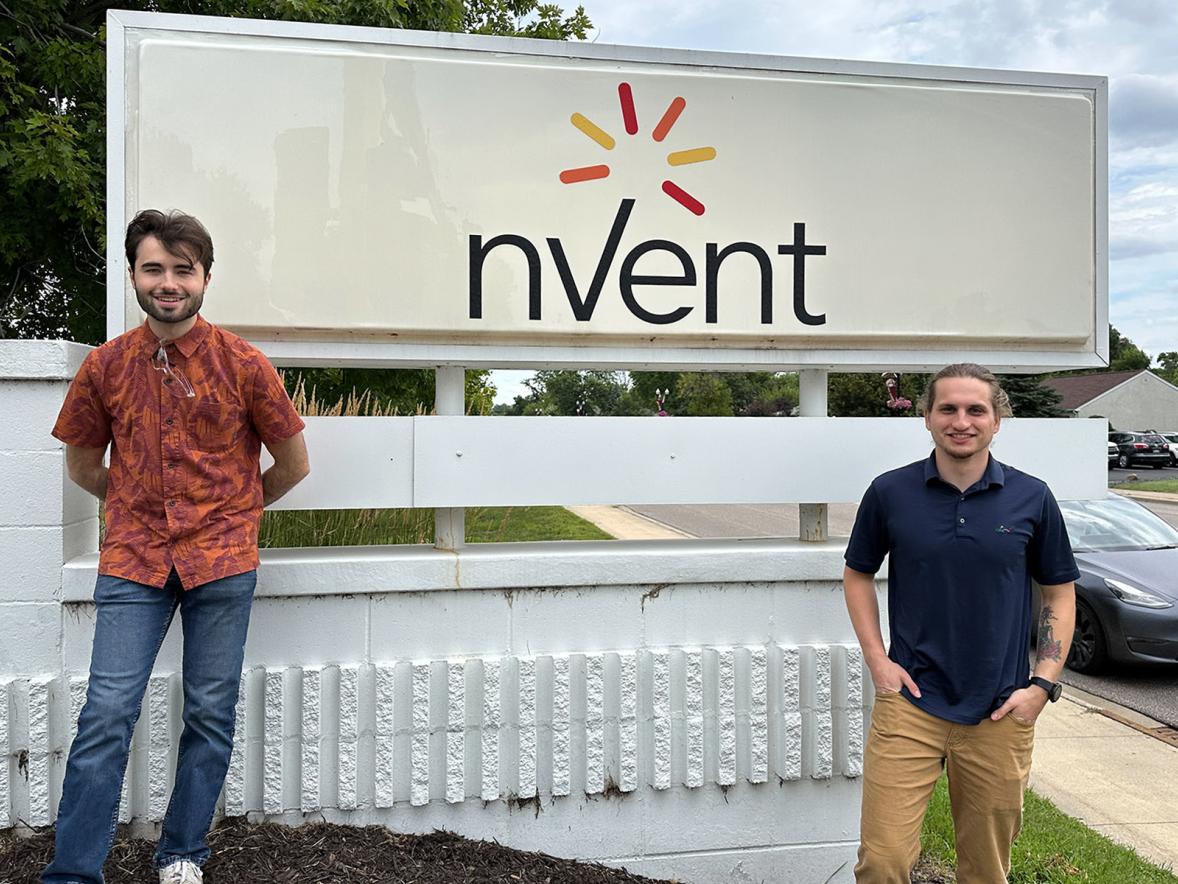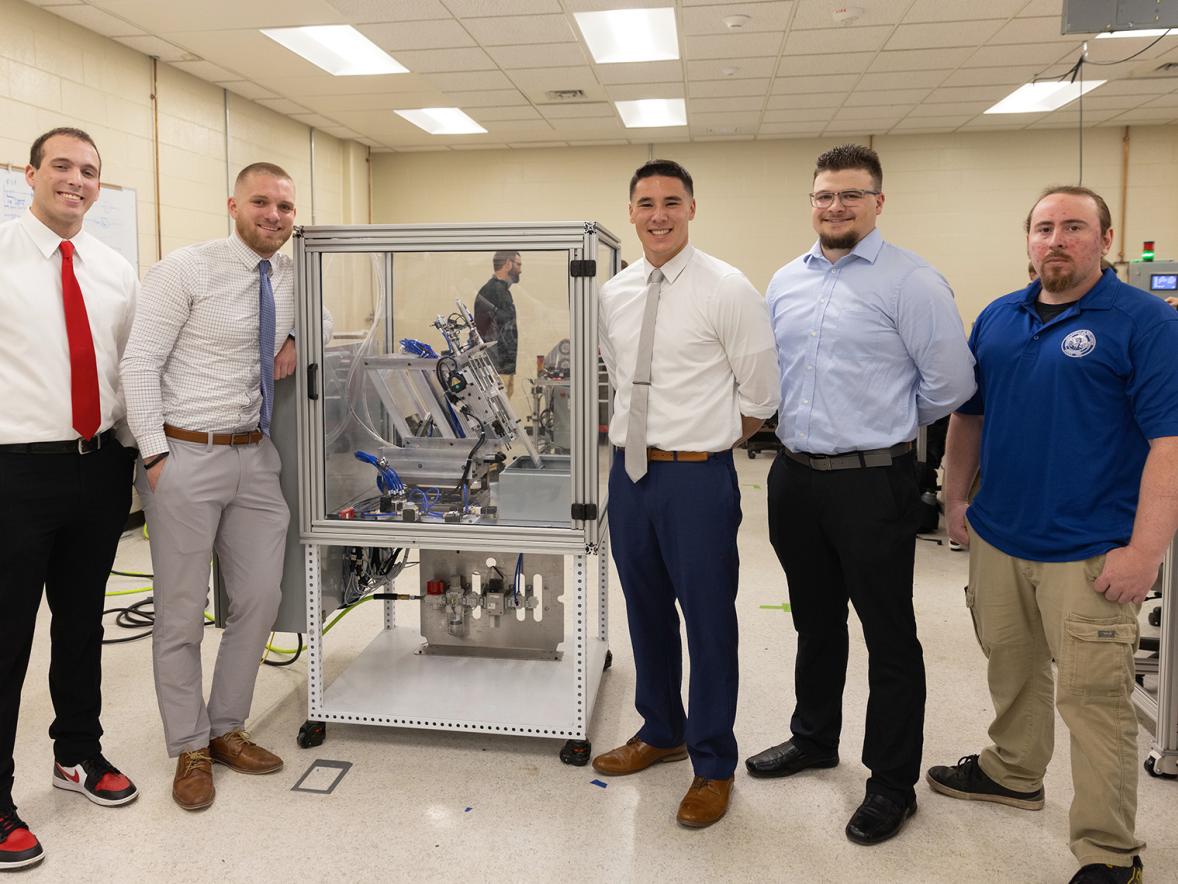Two UW-Stout computer and electrical engineering seniors helped develop and test the next generation of technology this summer.
During their controls/electrical engineering internships with nVent, Easton Sailer and Evan Pettit helped teams develop new high density liquid cooling – HDLC – products, supported existing products and interfaced with internal and external teams around the world.
HDLC systems are water cooling units for data center servers. They provide a more efficient and sustainable alternative to traditional air-cooling methods and enable closer component packing and greater computer capacity within the same footprint.

A $3.3 billion company with more than 11,000 employees worldwide, nVent offers industry-leading solutions for industrial automation, commercial buildings, power utilities, renewable energy, infrastructure, energy storage applications, and data centers, including HDLC development and support.
Sailer and Pettit’s internships at the Anoka, Minn. facility aligned with Program Director Wei Shi’s main goals for her CEE students, which are “to equip them with skills in solving real-world problems, develop practical abilities in analysis and design, and train them for and help them gain experience in working with industries before they even graduate.”
Experiences in product development and troubleshooting
Sailer, of Pound, Wis., took the spring semester off from school to start a seven-month internship last January.
“Water cooling units for data center servers are a relatively new concept in the field. While I was offered opportunities with other companies, I found this to be the most interesting because it reminded me of water-cooled gaming PCs but on a larger scale,” he said.
He explained CEE as the intersection of electrical engineering and computer science, interacting with both software programs and physical hardware devices.
“Another fun way I like to describe CEE is ‘tricking rocks to think for us’ because at the end of the day, that’s all it is,” Sailer said. “We create hardware devices out of materials found on earth like silicon, gold and copper and run software using digital logic to do tasks that humans find boring or repetitive.”
Pettit, of Rosemount, Minn., joined the nVent team in May, shadowing Sailer, who served as his mentor. They collaborated on projects daily.
While communicating with other teams, their responsibilities included creating plans; developing automated test scripts using Bash, a Linux software scripting language; collecting and analyzing data; and troubleshooting machines in the lab.
Various electrical tools they used were multimeters, a differential DC power supply and digital oscilloscopes to measure voltage and current of HDLC systems during troubleshooting or research and development, as well as physical tools, such as wire cutters, crimpers and strippers.
They had calls with customers and suppliers to perform root cause analyses, plan necessary tests and address their HDLC issues, including tuning the PID – proportional, integral and derivative – parameters of a motor to keep it running at a constant speed while its load varies due to its environment, Sailer explained.
“With the experience gained at nVent, I have a new perspective on the concepts that I’m learning at Stout,” Sailer said. “I had a great time working with Evan. It was really fun working with someone who is from the same school as you, and I was surprised how many people at nVent went to Stout.”
Pettit was initially intimidated by the idea of his internship, but he felt encouraged during his interview with a senior engineer at nVent, and he was excited to gain experience in product development, something he had never expected to do in his first internship.
“I quickly acclimated to the environment because of the support I received from Easton and other team members,” he said.
Career Services Director Bryan Barts said nVent provides UW-Stout students with a continuous source of opportunities for connections locally, regionally and internationally.
“In the past 10 years, we have experienced 60 students working at nVent,” Barts said. “As a company that is truly focused on sustainability, they have been able to attract and engage with several UW-Stout programs, including engineering, management and industrial technology across their company and brands.”
Dialed in: Engineering projects hum as students present prototypes to industry sponsors
Continue ReadingFor example, nVent sponsored a project in 2023-24 in UW-Stout’s Senior Design Experience capstone course for engineering majors.
This summer, 510 UW-Stout students, including 28 CEE students, were enrolled in Career Services’ Cooperative Education and Internship Program in 24 states.
An interest in electronics and embedded systems
Sailer has always had an insatiable desire to understand how things work and thought he would be a mechanical engineer. But that idea changed when he was 14, when he bought a used four-wheeler to fix and resell.
“I soon realized that beyond mechanical work, it also needed a bunch of electrical work. Although I knew nothing about electrical systems at the time, I taught myself by watching YouTube videos. After almost a year, I was successful in fixing and selling the four-wheeler for a profit. This experience made me far more interested in electrical engineering, and it was pivotal in my decision to be a CEE major,” he said.
Pettit was about the same age when he discovered his interest in electronics. He built his first computer in middle school and studied computer science and hardware in high school.
“By junior year, I was certain that I wanted to pursue a career in the field of information technology but was uncertain whether to concentrate on computer science or computer engineering. My final decision to study computer engineering was encouraged by the economic and career incentives, as computer engineers are currently in higher demand,” said Pettit, who will graduate in May 2025.
Sailer was very hesitant to take a semester off school for his internship, “but I am super glad that I did. The experience gained was well worth my time, and this job helped me to better understand what I would like to do with my career after college,” he said.
Sailer will graduate in December 2025 and would like to work for the defense industry in embedded systems engineering, which often includes developing software to facilitate secure communication between aircraft, ground control stations and other military assets.
Career Services’ First Destination Report stated that 100% of recent CEE graduates are employed or continuing education and have an average starting salary of $71,000.






